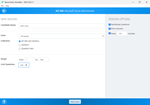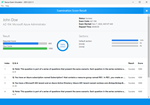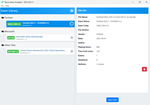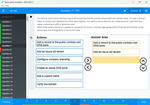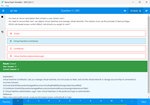Download Microsoft Azure Security Technologies.AZ-500.PremiumDumps.2025-03-29.365q.tqb
| Vendor: | Microsoft |
| Exam Code: | AZ-500 |
| Exam Name: | Microsoft Azure Security Technologies |
| Date: | Mar 29, 2025 |
| File Size: | 32 MB |
How to open TQB files?
Files with TQB (Taurus Question Bank) extension can be opened by Taurus Exam Studio.
Purchase
Coupon: TAURUSSIM_20OFF
Discount: 20%
Demo Questions
Question 1
You need to meet the identity and access requirements for Group1.
What should you do?
- Add a membership rule to Group1.
- Delete Group1. Create a new group named Group1 that has a membership type of Office 365. Addusers and devices to the group.
- Modify the membership rule of Group1.
- Change the membership type of Group1 to Assigned. Create two groups that have dynamicmemberships. Add the new groups to Group1.
Correct answer: D
Explanation:
https://docs.microsoft.com/en-us/azure/active-directory/users-groups-roles/groups-dynamicmembershipScenario:Litware identifies the following identity and access requirements: All San Francisco users and their devices must be members of Group1.The tenant currently contain this group: Reference:https://docs.microsoft.com/en-us/azure/active-directory/users-groups-roles/groups-dynamicmembershiphttps://docs.microsoft.com/en-us/azure/active-directory/fundamentals/active-directory-groupscreate-azure-portal https://docs.microsoft.com/en-us/azure/active-directory/users-groups-roles/groups-dynamicmembership
Scenario:
Litware identifies the following identity and access requirements: All San Francisco users and their devices must be members of Group1.
The tenant currently contain this group:

Reference:
https://docs.microsoft.com/en-us/azure/active-directory/users-groups-roles/groups-dynamicmembership
https://docs.microsoft.com/en-us/azure/active-directory/fundamentals/active-directory-groupscreate-azure-portal
Question 2
You need to ensure that users can access VM0. The solution must meet the platform protection requirements.
What should you do?
- Move VM0 to Subnet1.
- On Firewall, configure a network traffic filtering rule.
- Assign RT1 to AzureFirewallSubnet.
- On Firewall, configure a DNAT rule.
Correct answer: D
Explanation:
https://docs.microsoft.com/en-us/azure/firewall/tutorial-firewall-dnat https://docs.microsoft.com/en-us/azure/firewall/tutorial-firewall-dnat
Question 3
You need to ensure that you can meet the security operations requirements.
What should you do first?
- Turn on Auto Provisioning in Security Center.
- Integrate Security Center and Microsoft Cloud App Security./AZ-500.html
- Upgrade the pricing tier of Security Center to Standard.
- Modify the Security Center workspace configuration.
Correct answer: C
Explanation:
The Standard tier extends the capabilities of the Free tier to workloads running in private and other public clouds, providing unified security management and threat protection across your hybrid cloud workloads. The Standard tier also adds advanced threat detection capabilities, which uses built-in behavioral analytics and machine learning to identify attacks and zero-day exploits, access and application controls to reduce exposure to network attacks and malware, and more.Scenario: Security Operations RequirementsLitware must be able to customize the operating system security configurations in Azure Security Center.Reference:https://docs.microsoft.com/en-us/azure/security-center/security-center-pricing The Standard tier extends the capabilities of the Free tier to workloads running in private and other public clouds, providing unified security management and threat protection across your hybrid cloud workloads. The Standard tier also adds advanced threat detection capabilities, which uses built-in behavioral analytics and machine learning to identify attacks and zero-day exploits, access and application controls to reduce exposure to network attacks and malware, and more.
Scenario: Security Operations Requirements
Litware must be able to customize the operating system security configurations in Azure Security Center.
Reference:
https://docs.microsoft.com/en-us/azure/security-center/security-center-pricing
Question 4
You need to configure WebApp1 to meet the data and application requirements.
Which two actions should you perform? Each correct answer presents part of the solution.
NOTE: Each correct selection is worth one point.
- Upload a public certificate.500.html
- Turn on the HTTPS Only protocol setting.
- Set the Minimum TLS Version protocol setting to 1.2.
- Change the pricing tier of the App Service plan.
- Turn on the Incoming client certificates protocol setting.
Correct answer: BE
Explanation:
Refer https://docs.microsoft.com/en-us/azure/app-service/app-service-web-configure-tls-mutualauth Refer https://docs.microsoft.com/en-us/azure/app-service/app-service-web-configure-tls-mutualauth
Question 5
You need to create Role1 to meet the platform protection requirements.
How should you complete the role definition of Role1? To answer, select the appropriate options in the answer area.
NOTE: Each correct selection is worth one point.
Correct answer: To work with this question, an Exam Simulator is required.
Explanation:
A new custom RBAC role named Role1 must be used to delegate the administration of the managed disks in Resource Group1. Role1 must be available only for Resource Group1. A new custom RBAC role named Role1 must be used to delegate the administration of the managed disks in Resource Group1. Role1 must be available only for Resource Group1.
Question 6
You need to configure SQLDB1 to meet the data and application requirements.
Which three actions should you recommend be performed in sequence? To answer, move the appropriate actions from the list of actions to the answer area and arrange them in the correct order.
Correct answer: To work with this question, an Exam Simulator is required.
Explanation:
https://www.youtube.com/watch?v=pEPyPsGEevw https://www.youtube.com/watch?v=pEPyPsGEevw
Question 7
You need to deploy Microsoft Antimalware to meet the platform protection requirements.
What should you do? To answer, select the appropriate options in the answer area.
NOTE: Each correct selection is worth one point.
Correct answer: To work with this question, an Exam Simulator is required.
Explanation:
/AZ-500.html /AZ-500.html
Question 8
You need to deploy AKS1 to meet the platform protection requirements.
Which four actions should you perform in sequence? To answer, move the appropriate actions from the list of actions to the answer area and arrange them in the correct order.
NOTE: More than one order of answer choices is correct. You will receive credit for any of the correct orders you select.
Correct answer: To work with this question, an Exam Simulator is required.
Explanation:
Scenario: Azure AD users must be to authenticate to AKS1 by using their Azure AD credentials.Litewire plans to deploy AKS1, which is a managed AKS (Azure Kubernetes Services) cluster.Step 1: Create a server applicationTo provide Azure AD authentication for an AKS cluster, two Azure AD applications are created. The first application is a server component that provides user authentication.Step 2: Create a client applicationThe second application is a client component that's used when you're prompted by the CLI for authentication. This client application uses the server application for the actual authentication of the credentials provided by the client.Step 3: Deploy an AKS cluster.Use the az group create command to create a resource group for the AKS cluster.Use the az aks create command to deploy the AKS cluster.Step 4: Create an RBAC binding./AZ-500.htmlBefore you use an Azure Active Directory account with an AKS cluster, you must create role-binding or cluster role-binding. Roles define the permissions to grant, and bindings apply them to desired users. These assignments can be applied to a given namespace, or across the entire cluster.Reference:https://docs.microsoft.com/en-us/azure/aks/azure-ad-integration Scenario: Azure AD users must be to authenticate to AKS1 by using their Azure AD credentials.
Litewire plans to deploy AKS1, which is a managed AKS (Azure Kubernetes Services) cluster.
Step 1: Create a server application
To provide Azure AD authentication for an AKS cluster, two Azure AD applications are created. The first application is a server component that provides user authentication.
Step 2: Create a client application
The second application is a client component that's used when you're prompted by the CLI for authentication. This client application uses the server application for the actual authentication of the credentials provided by the client.
Step 3: Deploy an AKS cluster.
Use the az group create command to create a resource group for the AKS cluster.
Use the az aks create command to deploy the AKS cluster.
Step 4: Create an RBAC binding./AZ-500.html
Before you use an Azure Active Directory account with an AKS cluster, you must create role-binding or cluster role-binding. Roles define the permissions to grant, and bindings apply them to desired users. These assignments can be applied to a given namespace, or across the entire cluster.
Reference:
https://docs.microsoft.com/en-us/azure/aks/azure-ad-integration
Question 9
You need to ensure that the Azure AD application registration and consent configurations meet the identity and access requirements.
What should you use in the Azure portal? To answer, select the appropriate options in the answer area.
NOTE: Each correct selection is worth one point.
Correct answer: To work with this question, an Exam Simulator is required.
Explanation:
Reference:https://docs.microsoft.com/en-us/azure/active-directory/manage-apps/configure-user-consent Reference:
https://docs.microsoft.com/en-us/azure/active-directory/manage-apps/configure-user-consent
Question 10
You need to ensure that User2 can implement PIM.
What should you do first?
- Assign User2 the Global administrator role.
- Configure authentication methods for contoso.com.
- Configure the identity secure score for contoso.com.
- Enable multi-factor authentication (MFA) for User2.
Correct answer: D
Explanation:
To start using PIM in your directory, you must first enable PIM.1. Sign in to the Azure portal as a Global Administrator of your directory.You must be a Global Administrator with an organizational account (for example, @yourdomain.com), not a Microsoft account (for example, @outlook.com), to enable PIM for a directory.Scenario: Technical requirements include: Enable Azure AD Privileged Identity Management (PIM) for contoso.comReference:https://docs.microsoft.com/bs-latn-ba/azure/active-directory/privileged-identity-management/pimgetting-started To start using PIM in your directory, you must first enable PIM.
1. Sign in to the Azure portal as a Global Administrator of your directory.
You must be a Global Administrator with an organizational account (for example, @yourdomain.com), not a Microsoft account (for example, @outlook.com), to enable PIM for a directory.
Scenario: Technical requirements include: Enable Azure AD Privileged Identity Management (PIM) for contoso.com
Reference:
https://docs.microsoft.com/bs-latn-ba/azure/active-directory/privileged-identity-management/pimgetting-started
HOW TO OPEN VCE FILES
Use VCE Exam Simulator to open VCE files
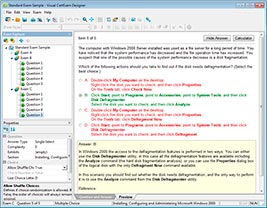
HOW TO OPEN VCEX FILES
Use ProfExam Simulator to open VCEX files
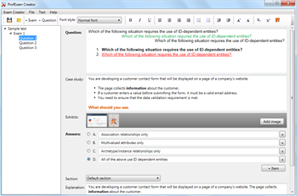
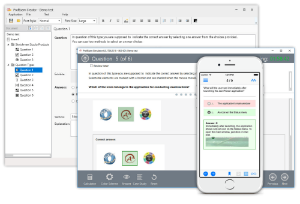
ProfExam at a 20% markdown
You have the opportunity to purchase ProfExam at a 20% reduced price
Get Now!